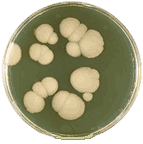Papers in the Biological Sciences
Document Type
Article
Date of this Version
6-2008
Citation
EUKARYOTIC CELL, Vol. 7, No. 6, June 2008, pp. 980–987. doi:10.1128/EC.00357-07
Abstract
Candida albicans is a dimorphic fungus that can interconvert between yeast and filamentous forms. Its ability to regulate morphogenesis is strongly correlated with virulence. Tup1, a transcriptional repressor, and the signaling molecule farnesol are both capable of negatively regulating the yeast to filamentous conversion. Based on this overlap in function, we tested the hypothesis that the cellular response to farnesol involves, in part, the activation of Tup1. Tup1 functions with the DNA binding proteins Nrg1 and Rfg1 as a transcription regulator to repress the expression of hypha-specific genes. The tup1/tup1 and nrg1/nrg1 mutants, but not the rfg1/rfg1 mutant, failed to respond to farnesol. Treatment of C. albicans cells with farnesol caused a small but consistent increase in both TUP1 mRNA and protein levels. Importantly, this increase corresponds with the commitment point, beyond which added farnesol no longer blocks germ tube formation, and it correlates with a strong decrease in the expression of two Tup1-regulated hypha-specific genes, HWP1 and RBT1. Tup1 probably plays a direct role in the response to farnesol because farnesol suppresses the haploinsufficient phenotype of a TUP1/tup1 heterozygote. Farnesol did not affect EFG1 (a transcription regulator of filament development), NRG1, or RFG1 mRNA levels, demonstrating specific gene regulation in response to farnesol. Furthermore, the tup1/tup1 and nrg1/nrg1 mutants produced 17- and 19-fold more farnesol, respectively, than the parental strain. These levels of excess farnesol are sufficient to block filamentation in a wild-type strain. Our data are consistent with the role of Tup1 as a crucial component of the response to farnesol in C. albicans.
Included in
Environmental Microbiology and Microbial Ecology Commons, Other Life Sciences Commons, Pathogenic Microbiology Commons



Comments
Copyright © 2008, American Society for Microbiology. Used by permission.